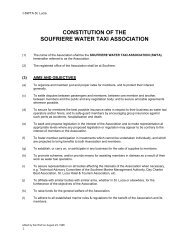WWF Cover photo - Soufriere Marine Management Association ...
WWF Cover photo - Soufriere Marine Management Association ...
WWF Cover photo - Soufriere Marine Management Association ...
Create successful ePaper yourself
Turn your PDF publications into a flip-book with our unique Google optimized e-Paper software.
2. Contrasting experiences from the Philippines: Apo and Sumilon IslandsCo-authored by Aileen Maypa, Project Seahorse, Philippines aileenpm@mozcom.comThe Philippines has a long history of the management of coral reefs and other coastal habitats using marineprotected areas, and now has a National Integrated Protected Area System, established in 1992. In a 1999 survey,Pajaro et al. (1999) identified 439 MPAs in the Philippines, with 44 being fully enforced. The 44 enforced areascover an estimated 26,500 hectares (265km 2 ) and mainly protect coral reefs, encompassing just under 1% ofPhilippine coral reef habitats. Nationwide fishery catch per unit effort in the Philippines has decreaseddramatically over recent years (White et al. 2002), but increases in catch per unit effort and fish yields have beenreported from a numbers of fisheries adjacent to marine reserves (see case studies below, and San SalvadorIsland, White et al. (2002), Christie and White (1994) and Garces and Dones (1998), in White et al. (2002)).ApoApo Island in the central Philippines has an area of 0.74km 2 (Maypa et al. 2002) and in 2001 had a population of700 (Maypa unpubl. data). <strong>Management</strong> began at Apo in 1976 when staff from Silliman University, on thenearby island of Negros, introduced a marine conservation and education programme. The idea to have a no-takearea evolved from this programme and in 1982 the community began protecting an area that is now known as theApo Reserve or <strong>Marine</strong> Sanctuary. The area is a 400m long section of reef along the southeast coast of theisland, protecting about 10% of the total reef area (Figure 1). In 1985, as part of the Silliman University <strong>Marine</strong>Conservation and Development Programme, a marine reserve plan was endorsed by the community whichincluded the 400m no-take section and also designated all the island’s reef to 500m from shore as protected.<strong>Management</strong> responsibility was given to the <strong>Marine</strong> <strong>Management</strong> Committee, a group of local residents. Themain objectives were to prevent non-residents fishing the island’s reefs, to prevent the use of destructive fishingtechniques, to protect habitats and breeding fish, to increase fish numbers in the no-take area and therefore localfish catches by export of fish, and to encourage tourism. The area became formally protected through legislationin 1986 (Russ and Alcala 1999).Figure 1: Map and <strong>photo</strong>graph showing the location of the Apo Reserve.The map shows the location of fish visual census transects (dashed areas)studied by Russ and Alcala. Photo by R. Raymundo and layout by J.L.P.Maypa.White and Calumpong (1992) carried out surveys of fishers’ opinions about the reserve in 1986 and in 1992. All21 fishers interviewed (representing 20% of Apo fishers) supported management of the area and the no-takereserve. By 1992 all the fishers interviewed had perceived an increase in their catch since implementation ofmanagement. Some fishers claimed their catches had doubled over the 10 years of protection. Most fishersinterviewed also said that the management programme had led to increases in tourism, although less than half(10/21) felt they were benefiting from tourism. The same number said that tourism was having negative effects,particularly dive boats arriving from other islands and damaging the reefs with anchors. In 1992 there was alsoevidence for good compliance with fishing regulations and the reserve (White and Calumpong 1992), andthroughout its 20 years of management Apo has been known for its strict enforcement and good compliance(Maypa et al. 2002).36



